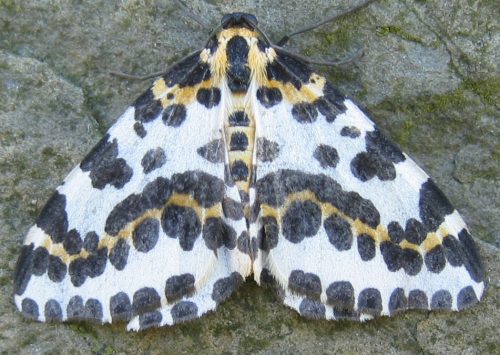Magpie moth, is a distinctive moth with striking black and yellow spots on white wings.
Do not confuse with:
Small magpie (Anania hortulata)
Magpie moth (Abraxas grossulariata). Moth belonging to the geometer moths (Geometridae). The Magpie moth has striking signal colours, which is why this butterfly (and the also colorful caterpillar) is not seen as edible by birds. This moth measures from wingtip to wingtip + 20 mm and are in the evening regularly attracted to light.
The Magpie moth can be found on gooseberries and raspberries on warm days from May to late August. The butterflies can be found in parks and gardens.
The over three inches long striking caterpillars are sometimes found numerous on the host plants raspberries and gooseberries, where they eat away at buds, blossoms and leaves. Sometimes they are also found on common hazels, blackthorns, bird cherries and spindles.
Starting in March, the caterpillars become active and feed on budding leaves and blossoms, then pupate in June. The pupae are attached to a twig or leaf with silk threads. The adult butterflies appear around mid-June.
The eggs are deposited on leaves during the summer. When the caterpillars hatch, they hibernate on branches in the shrubs. Usually there is only one generation per year.
Where to find
- Currants
- Raspberry
- Gooseberry
- Hazel
- Spindle
- Blackthorn
- Bird Cherry
Control
The caterpillars are not eaten by birds; catch them by hand. In horticulture, nematodes (roundworms) are used to to control large numbers of caterpillars.
Prevention
Does not apply.

